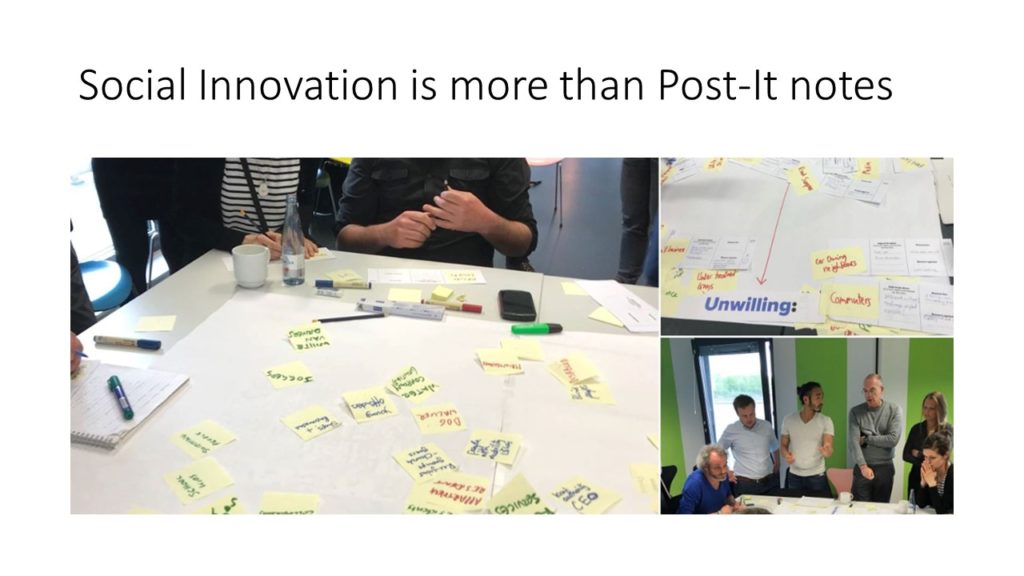This lab took take place on Thursday 20.2.2020 at Scotland House, Rond-point Robert Schuman 6, 1040 Brussels, after the SIMRA conference.
It aimed to explore how local initiatives or local action groups working in the context of CLLD can act as a motor and platform for social innovation at grass roots level. There are many connections between local development methods and social innovation, especially the pulling together of a stakeholder group involving the main public, private and third sector actors at local level and the engagement with end-users to understand problems.
These groups often go beyond economic development to address social and environmental issues in their localities. They build assets and local institutions often using forms of mixed market solutions such as social enterprise models and cooperatives to improve quality of life for citizens.
Concrete examples were discussed as well as how to build capacity of groups to deploy well tested models of social innovation. The emphasis was on the similarities and differences between social innovation initiatives in cities as compared to rural areas, as well as on urban/rural links. The Lab was introduced with a presentation by Peter Ramsden on urban social innovation, supported by various policy schemes – click below:[bsk-pdf-manager-pdf id=”71″]
Some points captured from the LDnet LAB discussion:
- The process should start with a shared understanding of what is the case – the state of affairs. It would be childish to avoid speaking about problems and having a sober look on it (for the sake to be ‘positive’ all the time)
- It’s so important to learn with peers. E.g. Maria Rosaria from VaZapp worked in a transnational city cooperation concerning GHG reduction in the context of the Covenant of Mayors. There she experienced how important knowledge sharing turned out to be.
- Example from Bristol concerning climate change mitigation measures: Instead of trying to showcase an ‘idealtypical zero carbon’ house which nobody could afford, the municipality asked the citizen to come up with THEIR solutions (regarding heating, insulation etc.) and share the individual approaches with others.
- The role of municipalities in urban social innovation seems to be much stronger in urban than in rural areas. This may have to do with the fact that they are the main hosts of policies and support schemes. Cities have their own resources for funding.
- Rural initiatives operate at inter-municipal and urban initiatives at sub-municipal level. There are also cases in countries with very large municipalities (e.g. Western Balkans), where the LEADER rules stipulate that a LEADER area has to englobe at least two municipalities, which already makes for quite a large area, and the influence of mayors and city administrations are still very strong, maybe too strong.
- Power is much more concentrated in urban environments than in rural ones.
- This makes that urban initiatives rather depend on POLITICS instead of POLICIES. If there is an enlightened ruling party/coalition with a committed mayor, a lot of things can happen (e.g. Seoul). But most municipalities are like blocks of wood, stiff, rigid and dumb with structures 50 to 100 years backward.
- In the examples presented by Peter Ramsden we very much deal with governance innovation which enable, foster, and encourage social innovation initiatives on the ground.
- URBACT has proven not being sufficiently responsive to new challenges (like the 2016 refugee crisis); way more initiatives could have emerged than actually have.
- Trust: It’s not that trust is higher in rural areas (the Apulian rural initiative VaZapp is about building trust among farmers via so-called “farmers’ dinners”; lack of trust had been identified as the main weakness), but in rural areas YOU KNOW whom to trust and whom not, whereas uncertainty is much higher in urban communities. However this is not always so simple. Neighborhoods with first generation immigrants behave like villages; they know each other. This dissipates over the generations. On the other hand rural and peri-urban settlements become more and more anonymous as new residents move in.
- To build trust, one has to address women first (e.g. women of fishermen, farmers).
- Change agents are often from the opposite realm: People with urban backgrounds are often promoting social innovation in rural areas whereas it is often rural people who start neighborhood initiatives in urban areas (e.g. Food Council in Berlin).
- In larger LEADER areas there are small towns included (e.g. Scotland). A lot of schemes and agencies are trying to do similar things and pursue similar goals. There are many people who say there should be made clean house in order to make support schemes leaner and more efficient. But this should not go unchallenged. A certain redundancy is good. Let all these things happen. The important thing is that there is transparency. People should know what is going on outside their own initiative, and exchange accordingly.
- Finally there was a discussion on scale. You can achieve a lot of things, but still have very little impact on a higher scale. Apart from the scalability of local innovations, there is the question: Can any (e.g. climate-related) initiative scale up as long as it is ahead of politics and policies?
- When we give our best to make things better we should not think about what impact this has on the large scale. That would discourage us. Ultimately we never know that in advance.
- Scaling may also happen by positive competition (awards) and other incentives that encourage local actors to import new approaches and also to improve them in order to become a model for others.
See also Robert’s contributions at:
The LEADER approach and social innovation in rural areas – a liaison?
Leave a Reply
You must be logged in to post a comment.